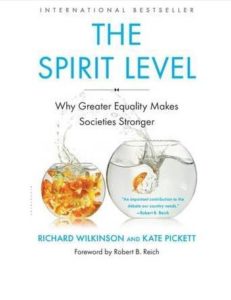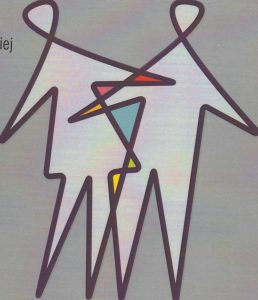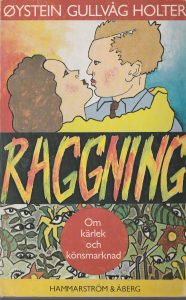
Author at the Margareta Church ruins, in the Maridalen valley north of Oslo, early March 2020
Blog post written March 16, updated March 22 and April 6, 2020
“There is no such thing as society” – ? The social profile of Covid19
A virus does not have any idea of social class, status, and other forms of ranking or hierarchy in human society. It just looks for bodies where it can survive and multiply.
The virus spreads to “somebody”, not just “anybody”, in our society. It doesn’t affect all groups in the population equally.
It spreads through people who create society through their practical lives.
The neoliberal idea that “there is no such thing as society” (Margareth Thatcher), that we are only individuals, is not very convincing in these times of trouble.
Epidemics have a social class profile, and this is an important perspective to keep in mind, as argued by Svenn-Erik Mamelund at Oslo Met, and other researchers. Mamelund warns that the effects of the pandemic will be worse, in lower income groups https://www.klassekampen.no/article/20200316/ARTICLE/200319974
The total cost of epidemics is usually higher among poor people and regions. This is why, as the WHO warns us, we need to worry about Africa and the poor world, in the current situation, not just the spread of the virus in Europe and the US. Poor countries will be even worse hit, and this will hit back on us, unless we can break the cycle.
The new corona virus is socially blind, it just jumps to the nearest somebody. Workers in high-contact jobs are more prone to get it, and people with more social contact. The transmission as well as the resulting Covid-19 disease has a social profile, with the death rate much higher among some population groups than others.
Although the patterns of disease transmission and development are partly cloudy, two facts emerge beyond doubt. 1) the disease selects by age, older people are more likely to get heavier symptoms and are more likely to die from the resulting worsening of the disease. 2) underlying health problems like heart problems and diabetes are also clear negative factors increasing the chance of dying from Covid-19.
Men go first
It is also clear that the death rate from the disease is higher among men than women. Yet the reasons for this are still in the dark. They are not well clarified.
It seems that, once again, “gender” is a topic that stands at the end of the queue, regarding research, even though, empirically, it is central.
I have looked for research on men’s larger death rate from Covid19 since late February. It is only in the last weeks that the issue has shown up more frequently, mainly in the media, citing recent and still rather fragmented research.
The numbers are only partly clear. I have not seen exact international statistics, regarding the gap between women and men’s chance of dying from the disease. My overall impression is that men stand a one and a half chance, to a double chance, of dying from the disease, compared to women. According to the Chinese evidence (based on the first 55 000 deaths), the chance of an infected man dying from the disease was 168 percent the chance of a woman dying from it (crude fatality rate). A more recent study (72 ooo deaths) shows a very similar pattern, 165 percent chance.
Why?
The first reports, from China, on the larger death rate among men, were tentatively explained by the much higher proportion of smokers among men compared to women in the country. Now, reports from Italy indicate that men are even more prone to die from the disease compared to women, than in China. The “extra male burden” of the new disease is maybe even larger in Italy than in China. Yet in Italy, smoking is more gender-balanced than in China. From age 60 upwards – the main part of the new disease death cases – the proportions of women smoking is circa 80 percent the proportions of men. The gender gap in smoking seems too small to explain the large fatality difference. See https://www.statista.com/statistics/501615/italy-smokers-by-age-and-gender/
I wrote about this in the original version of this post some weeks ago. Now (April 6) I see the same point picked up elsewhere also, e g in this informative text: https://www.wired.co.uk/article/coronavirus-death-men-women
There is recently more interest in gender issues, and I notice a move away from purely “external” explanations, like smoking, towards more integrated approaches. Even if damaged lungs doesn’t help, its not enough to explain the gender difference. The same goes for other biological or other disease factors. They are important, but they don’t explain all. Quoting from the above paper:
“Ultimately, biology, lifestyle and behaviour are all likely to play a role in the spread and impact of Covid-19. But it will only be possible to understand the exact differences between men and women once more countries produce and make available sex-disaggregated statistics on infection and mortality.”
Possibly, fatal cardiovascular disease, more common among men than women, is a more important factor behind the different fatality rates, than smoking. Studies point to a higher fatality among men at this point, maybe twice as high as women, and cardiovascular disease is the number one factor increasing the complications of the new disease, ahead of diabetes, and others, according to Chinese studies. However, this is probably also only part of the picture. The fatality from cardiovascular disease becomes more gender-balanced, among older people.
There are other medical or biological explanatory factors too, including better immune systems among women, and maybe hormone and chromosome differences, but the picture is still far from clear (as far as I can see).
Patterns of behaviour – our old friend “society” – most probably plays a large role.
Men and health
According to men and masculinities research, men are in situations that may work against good health, and often adapt to patterns of action and practice that increase the health problems. Men’s health behaviour is more often in the high risk zone, than women’s behaviour.
A dramatic example of this rule comes from studies of suicide. These show an almost universal global pattern – men suicide more often than women. Recent studies have also mapped suicide attempts, not just suicides. Here, the situation is the opposite. Women, not men, are most prone to attempt suicide. These studies show that when people consider suicide, men tend to do it, while women more often stay on the brink, they may attempt it, but they don’t go through with it.
Similar patterns can be found in other health-related behaviors. Compared to women, men typically take less (and later) contact with the health system, and are less open about problems. Even in gender-equal Norway, if a couple has a problem, it is typically the wife contacting the family councelling or therapist, dragging the husband along.
Greater fatality among men compared to women in different age groups and for different diseases and causes has been reported e g by the UK researcher Alan White (https://alan-keith-white.blogspot.com/2019/07/mens-health-and-womens-health-emerging.html).
These are relevant factors, even if they may not play the main role for the Covid19 deaths today. The health and social evidence are important parts of the whole. Another important data source on men and health is the International Men and Gender Equality Study (IMAGES, cf. https://promundoglobal.org/programs/international-men-and-gender-equality-survey-images/
It should be noted, that the idea of a “zero sum game” in terms of gender and health is rejected by most health researcher, even if it lives on in the media. Women’s health does not improve by men dying before them (or vice versa). Instead, women’s and men’s health problems should be seen in connection, and reduced in terms of better health behaviours from both (all) genders. Yet the idea stays on, in today’s media and debate.
According to the evidence regarding gender conceptions and bias, “fundamentalist” gender ideas may become stronger, in times of crisis or perceived danger. Crises may create “social panic”, a pattern mapped by researchers already in the 1960s. With more anxiety, studies show, there will be more of a backwards leaning on what is “safe”. Strict conservative gender rules are often considered “safe”. The evidence at this point is not conclusive (there may be gender innovative responses also), but it is clear that gender conservative fallback is a recurrent trend.
Generals planning for the last war?
Imagine what would happen, if women’s death rate from the new disease was almost the double of men’s. Would there have been an outcry? I think so. In gender-equal countries like Norway, at least.
I find it strange, based on the death rate evidence, that “male” is not included, and still not much highlighted and discussed, among the new disease risk factors.
Why not?
Is it mainly due to gender conservativism and a kind of automatic thinking? Men are more prone to die, this is part of the male role, with the man as protector and provider? We are “at war” with the virus, we are told. And men / soldiers are of course the ones most likely to pay their lives. So, the empirical red light warning, the much higher death rate among men, has mainly passed under the conceptual radar.
Class experts tell us that Covid19 will hit poor people worst. Gender experts tell us that women will be worse hit. This has been very visible in Norway, and internationally, as the media debate has taken up research issues, with more peope concerned about the “how” and “why” of the disease.
I think these experts, opinion leaders, or “generals”, are mostly quite correct, regarding strategy, or overall impact. Yet generals need to know about tactics too. Tactics is not about what happens some years ahead. It is about what happens today and tomorrow. The current empirical picture of transmission, hospital treatment and death from Covid19.
We need to untangle the overall long term effects of the disease, from the actual happenings here and now. Especially, we need to distinguish between the transmission group and the serious impact group (those who get seriously ill, and may die).
For a dramatic example, compare the Black Death. This also probably first started among poor people – we don’t know. It spread through tradesmen to Europe. A typical first stage is transmission through people with money and contacts.
This is now replicated in the European evidence including Norway. Here, ski tourists from Italy and Austria brought home the virus. Likewise, with the so-called Spanish Flu after World War 1, the origin seems to have been in the US, spreading to Europe and the rest of the world mainly through the military. Poor people, and women, usually get the largest total costs from epidemics, but the transmission, especially in the early stage, is another story.
Top down transmission
Instead of the poorest and the lower classes, we obviously have a situation with a “top down” type of distribution of the virus, e g in Norway.
It started with people with money and contacts, mainly. And the fatality rate seems to be quite high, in these groups also. The lack of attention to the top down spread is evident in Europe and elsewhere with leaders in isolation, or infected.
Crying wolf regarding the working class, or women, is important in an overall perspective, but may be misleading, here and now. To understand and reduce pathways of infection and death from the disease we need to look at the upper/middle class, people in occupations with much contact – and men.
There are two different main groups involved, in reducing the total damage to society – the transmitters, and the seriously affected. Their social profiles started quite similar, but are now more diverse, as the disease spreads downwards in terms of social class, gender and ethnicity.
This is now quite clearly confirmed by local evidence from Oslo, capital of Norway. At first, the transmission was largest in the most affluent parts of the city. Recent evidence shows a shift towards the less affluent parts. Maybe, in some weeks time, these areas will be on the top of the list of infections per capita. The transmission will still be somewhat top-down, probably, but less so, than in the first phase.
This prediction fits the international Covid19 statistics (see e g Worldometers). Here, the numbers still read like a “rich world” club of transmission and deaths, with the rich world country deaths outnumbering the poor countries, and with the “epicentre” moving, with US rising fast, and Europe slowing down, while poorer countries – so far – have far lower rates.
This will most probably change, according to top down transmission class and gender analysis and historical epidemic evidence. We shall see. What is clear, here and now, is that top down transmition is shifting into wider transmition, going further out and downwards in terms of social status (class, gender, and others).
It seems that some of the bias and outmoded thinking in the first stage of the disease – where the gender death rate imbalance was almost totally overlooked (in February, early March, in my evidence), and the top down transmission evidence was mainly ignored (again, in my impression) – was due to the way expert researchers have conceptualized their work. They are into “gender”, for example, but in a quite restricted way, where gender mainly means “women”. Where men are assumed to be of less interest, and/or less gender-equal.
This gender-means-women bias is quite typical, in my experience, in international organizations, for example. Likewise, in terms of class, there is a common response, class means the lower class. Is this approach wrong? On the whole, no. But like I said, it is not the full picture. Tactics differs from strategy. Tactics involves the empirical material, here and now. At that point, experts have been slow to respond, in my view.
Since women generally live longer than men, and age is the number one factor increasing Covid19 fatality, we might have expected more women than men dying from it. Yet this is not the case. This underlines the need to investigate gender differences further.
Summing up
Clearly, better knowledge of the “hidden” gender dimension is needed. Researchers and experts need to cooperate, to create the best possible socio-medical-biological mapping of how Covid19 spreads, how it develops into serious illness, and takes lives – and how it can be reduced.
It is now clear that this will be a long-term pandemic. Gender is one of the central variables regarding the death rate from Covid19, and the reasons for this, still mostly unknown, are important for research and prevention.
The social part of the mapping of Covid19 should include social class, gender, ethnicity and other factors. This is vital and urgently needed. Gender may be a key factor, to reduce the disease and the social and economic cost of the pandemic.
Today (April 4), in Norway, there is really no telling how many have been infected by the virus. This is because testing equipment has become scarce and testing is not at all on the level of the WHO recommendation (“test, test, test”). So, experts and health workers are trying to trace transmission paths through a very limited number of test numbers. This is clearly far from optimal.
But at this stage, a social probability map – and guidelines – who, to test – is very important. Where to look, to find the transmitters. Social science cannot predict this exactly, of course, but it can help out, making it more likely that the tests that are actually done, find their target – the transmitters.
Author following Covid19 news on a mobile phone, April 6 (reading some good news, maybe light in the tunnel, now.)

Harriet Holter and Erik Grønseth
Norwegian and Nordic gender research was often radical and innovative in the 70s and 80s. Erik Grønseth and Harriet Holter were two of the pioneers, in Norway.
In this 1987 paper, Harriet Holter discusses Metoo problems, long before more open information was available, long before Metoo.
I cannot find this text on the web, so in this age of open access, I make a copy. You can find it here.
Holter Harriet Seksuell kultur overgrep og gjensidighet 1987 IMG_20200310_0001

At last, very delayed, I have read this 60s classic:
I am embarassed, I should have read it long before, this is glittering analysis, a beacon of a book, everyone should read it, its a true classic of the 60ies.
What does it say, more exactly?
Eichmann did not start out as a killer. On the contrary, his job was to “export” Jews – to somewhere. He got clever at this, threatening and pushing Jewish councils, so they cooperated, and paid much of the price for the “export”. At the start, the end of the export was some other place. Later, it meant death. Eichmann claimed he did not know. He was only the master of the trains and transportation, shipping out Jews, to “somewhere”. His main worry was that the Nazi hierarchy didn’t recognize his effort, to get this whole system going, based on his former recruitment of Jewish participation to the migration deals. The bigger bullies in the Nazi chain of command did not fully recognize his manly efforts! This was what most worried Eichmann, even as he sent millions of Jews to the death camps. This is the “banality” that Arendt describes so well.

A new capitalism analysis?
Yes, new capitalism analyses do appear. Although fairly rarely, maybe. It is not just the old stuff on how capitalism is bad – or good. Not just the old black and white treatment.
Two fairly recent examples include Richard Wilkinson and Kate Pickett: The Spirit Level (2010), and Thomas Pikketty: Capital in the Twenty-First Century (2014). Both works created a lot of scientific debate. Instead of condemning or praising capitalism in general terms, these pioneer studies went into the empirical terrain – what actually happens, in capitalist economy, viewed from our own time.
 Both books have the merit of a clear empirical hypothesis, and a theory updated around that central fact. In the case of The Spirit Level, the central empirical fact or pattern is the build-up of psychological and health costs related to capitalism, or at least, some very hardline or competetive forms of capitalism. In essence, there are good psychological and health reasons to avoid too much or too hard capitalism. The fallouts and dysfunctions are bad not just for those who fall out of the system, but for the system also, including the upper class.
Both books have the merit of a clear empirical hypothesis, and a theory updated around that central fact. In the case of The Spirit Level, the central empirical fact or pattern is the build-up of psychological and health costs related to capitalism, or at least, some very hardline or competetive forms of capitalism. In essence, there are good psychological and health reasons to avoid too much or too hard capitalism. The fallouts and dysfunctions are bad not just for those who fall out of the system, but for the system also, including the upper class.
Pikketty’s argument is more detail-focused. He goes into one highly significant “detail”, the percent of the total product value taken out by the owners of the production process. He finds a clear historical tendency – the share given to owners is rising, and the rise is notable in the period from the 1980s-today. From the conclusion:
“A market economy left to itself … contains powerful forces of divergence …… the principal destabilizing force has to do with the fact that the private rate of return on capital, r, can be significantly higher for long periods of time than the rate of growth of income and output, g. The inequality r > g implies that the wealth accumulated in the past grows more rapidly than output and wages. (…) The entrepeneur inevitably tends to become a rentier, more and more dominant over those who own nothing but their labor ( p 571).
There are different ways to interpret this, but there seems to be little doubt that the new findings give a fairly historically correct picture. Pikketty’s “facts” are even more broadly acknowledged than those of Wilson and Pickett.
None of these works highlight gender discrimination as such, although it is mentioned in The Spirit Level.
Gender equality is assumed to be a fairly peripheral factor, which is a mistake, in my judgement of the state of the research, including my own studies.
Instead, the main discrimination factor is social class or status – rather than gender, ethnicity, or sexuality.
The empirical message seems strong, but I would like it to be tested for control variables like gender equality.
The main message of Wilkinson and Pickett, and of Piketty, is that more social class divides will create more problems. Although starting from different disciplines and problem formulations, the two projects converge in their analysis – which is significant, I think.
Beyond these empirically oriented works, I have a lot of “imaginative” books on capitalism, in the bookshelf by my desk. Like; “How will capitalism end” by Wolfgang Streeck. Hardt and Negri: “Empire”, and books on the follow up debate. In my bookshelf, Steven Lukes: Power: A Radical View, sits besides Judith Butler: Undoing Gender. Eric Anderson’s Inclusive Masculinity is not far away.
Why? The subject is cross-disciplinary. What is called capitalism in one book may be called masculinity in another.
References
Piketty, David 2014: Capital in the Twenty-First Century. The Belknap Press of Harvard University Press, Cambridge Massachusetts
Wilkinson, Richard; Pickett, Kate 2010: The spirit level. Why greater equality makes societies stronger. Bloomsbury Press, New York

It looks a bit sad, maybe – the cover on Harriet Holter’s doctoral thesis, published by the University press (Universitetsforlaget), Oslo, 1970. The cover was made by me and Iben Hjort. No brains involved. Empty at the top.
What did Harriet Holter actually say, regarding gender differentiation and stratification? Her text was a world first – or a very early candidate, to distinguish more clearly between these dimensions. Here are some excerpts.
‘The concept of sex differentiation is in the present work often distinguished from sex stratification, that is, from the ordering of the two genders in terms of power and social prestige.’ p 18.
‘In the language of exchange theory, the net results of the differentiation accorded each partner must be great enough to keep motivating the exchange.’ 21
Some stratification counters differentiation:
‘Gender stratification [means] that men, in general, have more power and higher prestige than women. In what sense is this a reasonable postulate? Everyone is classified by many criteria in addition to sex. Sex is only one of several attributes that affect a person’s total prestige. It is assumed, then, that men tend to be evaluated more highly (..) when all other status criteria are similar for the two.’ p 44.
‘A functional explanation of the common rank order between men and women would have to postulate that women’s tasks, that is, to give birth to children and take care of them and rear them, is less necessary for society. (..) This position seems untenable. Gender differentiation, not gender stratification, may promote basic societal requisites like protection of the young and securing a close contact between infants and nourishing mothers. (..) Once men and women are differentiated with respect to responsibilities for infants, the two sexes differ in their opportunities for securing wealth and power.’ p 45
‘Women’s ties to their infants create immobility that is incompatible with many kinds of instrumental activities. (..) Instrumental activities are valued more highly than expressive ones especially in modern society.’ p 46
‘Expressive tasks devalued since they are less easily evaluated, dont give control over large resources (like some instrumental tasks).’ p 47. ‘Unlike expressive roles, instrumental ones require the delay of gratification, which helps in the control of resources’ 47
‘The more differentiated in the traditional manner are the tasks of men and women, the more likely it is that the stratification is marked. (..) [Yet] Certain forces act counter to these processes’. 47-48
‘The complementary natures of sex roles … is also a basis for the development of female forms of power as well as male ones.’ 49
‘The main hypothesis [in research] about improvements in the exchange positions of women follows from their increased occupational participation.’ 50 ‘Women do not have to use sexual favours as goods-in-exchange, a fact that enables them to enjoy sexuality as a pleasure in itself. And it might be added, women’s freedom with respect to choice of marital partner is increased.’ p 50.
Harriet Holter compared sex and race as examples of ‘ascriptive differentiation. Due to the conventions at her time, she here uses the term differentiation, rather than stratification, and states (p 51), that “One characteristic of sex differentiation, and partly of race differentiation (..) has been the change in the definitions of criteria from legal rules to informal norms. Such a shift seems to have taken place in all societies that have experienced prosperity in recent times.” She concludes that “sex differentiation, like other functional differentiations, entails a rank ordering of the positions of men and women.” (p 53).
In chapter two, on sex differentiating norms, she defines “sex roles or gender roles” (p 54) more precisely – this is “stable, patterned and sanction-carrying expectations about a person’s behaviour”, “the sum of norms directed towards a person occupying a certain position.”
Later, she discusses why gender is not class – a different type of ranking mechnanism, p 225. She notes that women are sometimes more conservative than men, ‘more in favour of ascriptive principles than men’ 230. ‘Sex differentiation may support class stratification by reducing tensions produced by the stratification’ 231.
Here we are into the heart of the matter. Renewed and increased class stratification may be eased by going back to a more traditional gender role system.

Each year, since 2012, the Schengen Peace Foundation and the World Peace Forum award the Luxembourg Peace Prize, an award that “honors the outstanding in the field of peace”. The categories of the Luxembourg Peace Prize and their celebration “amplify the aims and goals of the World Peace Forum”. This year, the award for “outstanding peace organization” was given to Promundo.
The prize for “outstanding peace activist” was given to Masami Saionji and Hiroo Saionji of the Goi Peace Foundation and May Peace Prevail On Earth International, based in Japan. Thich Nhat Hanh received the award for “outstanding inner peace”.
Since its founding in Brazil in 1997, Promundo has worked in collaboration with partners to advance gender equality and prevent violence in over 40 countries around the world through research and evaluation, targeted advocacy efforts, and evidence-based educational and community-wide program implementation.
The research model and its links to implementation and innovation are a main part of the reason why Promundo received the prize. The prize statement specifically mentions “high-impact research”. Cf https://luxembourgpeaceprize.org/laureates/outstanding-peace-organization/2019-promundo/
The new research is also used in the recent State of the world’s fathers report (cf https://genderjustice.org.za/publication/state-of-the-worlds-fathers-2019-executive-summary/), which has drawn attention from media including The New York Times (https://www.nytimes.com/2019/06/07/us/parents-fathers-role.html )
An important part of this research model was developed in Norway. Here is the background. And some ideas, how to follow up. 7 points, in all.
 (detail of cover of Brandth and Kvande, editors: Fedrekvoten [The father quota], 2013)
(detail of cover of Brandth and Kvande, editors: Fedrekvoten [The father quota], 2013)
1
A main part of the Promundo research effort started from a new type of gender equality survey made in Norway in 2007 in a project and survey called “Gender equality and quality of life”. The survey included much more detail on gender equality than previous studies, including more perspective on men as well as women, more focus on gender equality not just in opinions but also practices, household care and work divisions, and well-being, health, conflict and violence.
2
The Promundo team developed the Norway survey framework into a more relevant and applied version applicable in the global south, focusing on violence and health issues, and expanding the practical experience questions. In the first 6-country survey (2009-11), about 60 percent of the questions were taken from the Norwegian survey. The Promundo survey was called IMAGES – International Men and Gender Equality Survey. Later, as Promundo and local partners have adapted the survey in new contexts, now more than 40 countries, many of those core questions have continued to be used. And the logic of gender equality being related to quality of life continues to be a key conceptual framework for the studies.
3
The survey design was further developed by the Promundo team in a variety of contexts and collaborations, including cooperation with researchers at the Centre for gender research, University of Oslo. In some respects, it goes far beyond the original Norwegian project, although main questions and an important part of the framework remained the same.
4
The Promundo development mainly concerned actions – more than structures. The original Norwegian model had more emphasis on mapping structural factors hindering or helping gender equality. Later, an independent development of the structural part of the design was made in a Poland-Norway study (2015). Several books and papers have been published from this project (called GEQ – Gender equality and quality of life).
The Poland-Norway study includes a “European blueprint” for a wider European project, combining a developed survey questionnaire with interviews and other data. See http://www.geq.socjologia.uj.edu.pl/en_GB/start?p_p_id=56_INSTANCE_ZGJFS82ydNo6&p_p_lifecycle=0&p_p_state=normal&p_p_mode=view&p_p_col_id=column-2&p_p_col_count=3&groupId=32447484&articleId=136474060 – The Promundo survey developments gradually also included structural factors.
5
However, a comparison of these partly independent developments of the same research model remains to be made. The original gender equality model focused on a number of broad factors to be investigated regarding the “state of gender in/equality” – how to measure this as an independent dimension, in society. These included gender equality in childhood and youth, in working life, public sphere, family and household, etc. The presumed factors were designated mainly as “structural” but included cultural variables also. The design had a social-psychological dimension.
6
Why has the research model been a success? It goes into a not so well known area, men and gender equality, combining action questions with structure questions and cultural questions. It is focused on important issues like health, caring, conflict and violence. It s not a “cover all” but offers a more detailed map than other research designs. Weak spots can be reduced by combining surveys with other methods.
A main reason for the success, in my view, is the combination of action and structure aspects. This means that trends and actions among men (and women) can be analyzed with more nuance and precision, regarding structural factors. You get more information on specific themes like violence, especially in the IMAGES version, and also tools to adjust for different social and cultural context, including five main dimensions of gender equality and (in less detail) other discrimination experiences. This makes for a powerful tool. It is a bit like a “meme”. Once you have this new mapping, you don’t want to be without it. In principle, investigation can be focused and targeted, and remain balanced, un-prejudiced.
7
Analyzing the total evidence, both the new European studies and the new global studies, is a main issue now. It needs to be done. Through our center at the University of Oslo, I have cooperated with Promundo in order to get this issue into the prioritized European research agenda. So far, without funding. I hope this will change, now.
There is no doubt whatsoever that this research effort on gender, men, women, violence and conflict, health and well-being – is of great importance not just in itself, but also in relation to other top priority research areas. How to reduce social discrimination. How to resolve burning questions of climate change. How to engage men and boys as well as girls and women in positive gender equality change.
Now more than ever, with so much interest in the topic of engaging boys and men by donors, governments and academics, the IMAGES dataset, together with the European dataset, is an unprecedented resource for analyzing these issues, and considering how to bring other topics into new surveys, and begin to carry out the survey again in the same countries 10 or 15 years later to assess change. Furthermore, given that Gates Foundation supported Promundo to unify and clean up the global dataset, Promundo and the University of Oslo are well-placed to carry out this analysis – building theory, identifying gaps and opportunities, and making IMAGES and European tools, questionnaires and interview guides even more available to interested researchers.

I have been reading Chris Beckett’s science fiction novel America city – a direct extrapolation from today’s events in the US. A hundred years from now, the south of the US is no longer liveable. Immigrants flow to the north. But to win the election, presidential candidate Slaymaker has to relieve the burden on the northern US states. His outspoken female (and partly feminist) advisor comes up with an advice: what about Canada, they have room for our refugees. With scary but quite probable results.

This book, together with the great conclusion of the Dark Eden trilogy, Daughter of Eden, makes Beckett my favorite current sci-fi author. There, he goes into the mind of a “ghostspeaker”, the kind of woman prophet-sayer that is otherwise not much credited in science fiction. In America City, it is the mind of a US president wanting to build walls. Beckett looks from the inside. He goes into the mindset of the “others”.
Top of today’s literature, if you ask me.
After reading America City, it was somewhat of a shock to discover this record – Ainais Mitchell: Hadestown – Why we build the wall. I had not known this before.
I read, it is now a Broadway musical – I would love to see it.
To soothe my mind, I play a record dedicated to another vision of America – one of openness and acceptance:

How come boys and young men wanted to grow their hair long, going against the dominant social norms in the 1960s and 70s?
They were seen as girls, devalued and unmanly. Yet long hair became a way to demonstrate a youth revolt and a counter culture.
I am reading a lot of books, including music histories, for a book project on men and masculinities, in order to understand this change.
“All you need is ears”, Beatles producer George Martin argues, regarding the success of the Beatles – the leading long-haired band.
This is a good book regarding sound – a focused yet limited regarding the artistic contribution of the Beatles (and their sound as part of their artistic intention). Martin writes a lot about the technical issues and troubles with analog recording, with too few tracks and too much noise, and the text (written in the late 1970s) is more technical than emotional.
Yet this is the text of a record producer, not an artist, and should be judged on its own merits.
Much of what he says about analog recording, written before the advent of digital recording, which emerged some years later than this text (in the early 1980ies, with CDs supposed to represent “perfect sound forever”) is still relevant and interesting today. His book gives valuable knowledge, for example, on how to set up microphones, how to adjust for different instruments, and how to get the full sound of a band.
George Martin the producer and sometime-co-musician with the Beatles was never fully credited for his work. This is made very evident in the last part of the book. His complaints are reasonable, but his nagging tone, bringing up the theme, also reminds me of other recent music books I have read, in the direction, “I should have been paid x times more”. Artists and contributors often start out from artistic and idealistic reasons, but often end up – even if they sell well (or, especially in that case) – in conflicts regarding revenues, profits and egos. With maybe the ego part the hardest territory to negotiate. Alltogether, the in-depth books I read, including biographies of rock bands, artists and producers, describe a complaint against music capitalism. You can make a hit, but from then on, you are on the run.

I am writing a book on young men breaking the gender barrier, “looking like girls”, growing their hair long in the 60ies and 70ies. Since I have other tasks it moves ahead a bit slowly. However, I read source material, especially, music biographies and books.
Recently I’ve read Townshend, Pete 2012: Who I Am, and Cushman, Marc: Long distance voyagers – the history of the Moody Blues (vol 1 1965-1979). Both contain interesting glimpses of the aversion against young men with long hair, and the way the hair was – so to speak – entangled with the new youth culture and progressive music.
As a music sociologist, I think they err on each side of the road. The two books have two different kinds of limitations.
Townshend lays out claims that he was the first doing power chords, and came up with other inventions, but he tells surprisingly little of the musical development in the band and how this impacted on the band relationships. It is more like, this band mate was strong / not so strong.
Cushman’s first part – a massive volume on the Moody Blues, will there be a second? – on the other hand, goes all into the music. The social context is more sparse. And the text uses a lot of space for listings of the band’s record sales, rather than the music itself. Nevertheless, it is clearly the new standard of scholarship on this band. Yet even here, I would have liked better analyses of what exactly the Moody Blues did, that was musically new.
Plus points in Cushman’s book include glimpses of Ray Thomas as alto flute player (and other musicians in the band) combined with the production talents of “the sixth moody” Tony Clarke. The credit to Clarke is well deserved. Decca was quickly learning and developing production technique developed at EMI (Abbey Road), and had very high standards from earlier recording also, surpassing EMI in some respects.

Cusham is great on how the Moodies – this unlikely bunch of old-style-singing long-haired guys with somewhat uncertain instrumental prowess – were allowed into the Decca “holiest of holy”, with the new Deram sound system (DSS), using two four-track recorders for better stereo. The band was supposed to play classical easy listening music. They barricaded themselves in Decca’s best studio, and ended up inventing something new, in the typical spirit of the day. The result was Days of future passed, one of the larger-selling LPs of all time.
Townshend mainly tells his own story, and somehow, I find the connections to the music rather weak. Fans of The Who may love the band for “inventing” this or “doing” that, but what actually happened, musically? Maybe this critique is unfair. Townshend does tell about his attempts to go further, to develop music beyond what the band had done so far. Later in the book he says that the band had done a lot of jumping and showing off, this would not do anymore.
Inadvertently he also tells a story of how “youth” wasn’t a staying ground for the attempted change.
I would have hoped Townshend took some self-critique for lines like “Hope I die before I get old” – but it is only implied. Like, maybe we DID smash up a few guitars too many. This is the tone of the book, as I read it. Townshend’s book has elements of defense that I won’t go into here. Maybe it spilled over, also into his judgement regarding things back then. Maybe a revised version could work this out better.
Bands like The Who took the “soft” message of the youth revolt and the counterculture, and “hardened” it. What happened, in that transition?
Cushman is fine on the music, but the wider social context, culture etc is often largely absent. How come these nice Birmingham lads, singing in almost 1950s style, were tuned on to the new youth rebellion and counter culture? I wasn’t much wiser, even after 700 pages.
Was the Moody Blues, on the road, a much more orderly affair, than The Who? Less misogynism and use of groupies? It seems so. The books show that male bands could have quite different wishes and setups. Although the different filtering of the story telling applied by the two authors may play a role.
Was the creative process of both bands hindered, by the music industry, the emphasis on commercial hits and best-selling albums? Again, it seems so. Despite variation the basic story is remarkably similar. Did this, all in all, create a more “masculine” idea of music? Now we are into speculation territorry – but it may seem so, yes. In various ways. Ending with the synth-pop of the 80s. Long-haired bands becoming dinosaurs, one way or the other. In fact, you maybe don’t need Reagan or Thatcher or digital sound problems into the equation, to predict the generally agreed-upon “bad sound of the 80s”. Just add “band pressure” working over time.
For example, listen to Moody Blues: Octave album, Steppin in a slide zone (1978). This sounds so bad, it maybe sounds great. If you like the 1980s sound. The flat synthetic sound reminding me of shoulder pads for men. Short hair once again. A kind of prophesy of the 1980s music letdown. Was Clarke out to lunch? Anyway, almost everyone agrees – with Octave, we are no longer into the “classic” period of the group. Artistic quality is falling. Why? Constant pressure from a commercial machine is – broadly – the best answer.
Octave was made after the group was totally exhausted, having made seven albums, later called “the classic seven”, in a period of nine years. Likewise, the Who and other groups were pushed beyond their limits, by very high demands from the record companies – entangled with their own wishes to make money, while the attention was there. “Do it now”, like Paul McCartney advises on Egypt station. Everyone remotely musical and socially engaged, 1965-75, felt like a storm was coming on, a counter culture expressed especially in music, a new truth that could not be denied, or at least, a new level of public discourse, an extension of democracy, “love” as in empathy, etc. So – the behaviors and conflicts of the bands – can be read in this larger perspetive, they were a new type of organizations, that tried to spearhead the youth revolution and the counter culture, but encountered great costs along the way.
Both books are well worth reading, if you are interested in this period, and its wider repercussions. They both give some guide into what to listen for – albums, songs – and a musical follow-up is interesting.
Best place to start with the Moody Blues is maybe To our children’s children’s children (1969), perhaps the most successful of their classic seven albums. Then try Questions, on A question of balance (1970). If this doesn’t rock you, nothing will.
:format(jpeg):mode_rgb():quality(40)/discogs-images/R-3571823-1378397821-2878.jpeg.jpg)
Best place to start with The Who – I have not decided yet. Listening to Tommy and Quadrophenia, The Who sells out, A quick one. The early stuff is often the most interesting. Maybe all in all the best intro, to get the feeling of the band, is The Who sells out.
:format(jpeg):mode_rgb():quality(90)/discogs-images/R-2229657-1338708241-6734.jpeg.jpg)

It feels strange, now, looking at a book I wrote many years ago.
The cover by Klaus Nordby is great – one of the best I have had, on the books I have published. You can see a key as well as a broken heart.
My own bookshelf copy is pictured here. It has been useful, opened many times.
What does the book say? Well – read it!
It is in Norwegian, and the title – translated – is “Dating, love and the gender market” (Sjekking, kjærlighet og kjønnsmarked). Pax, Oslo 1981.
The title starts with the Norwegian word “Sjekking” which is not so easy to translate (literal: checking, checking up). “Dating” is not quite precise, especially as it relates the practices in the US that were never common in Norway. Picking up a partner is maybe more realistic, on the whole, but the English words are not so clear.
There was a Swedish translation of the book (Hammarstrøm och Åberg, 1983) – using the word “Raggning” for the Norwegian “Sjekking”.
The cover (by Johan Petterson) shows another angle – a kiss above, a jungle below.
Note those eyes…
Sadly, the book was never published in English.














